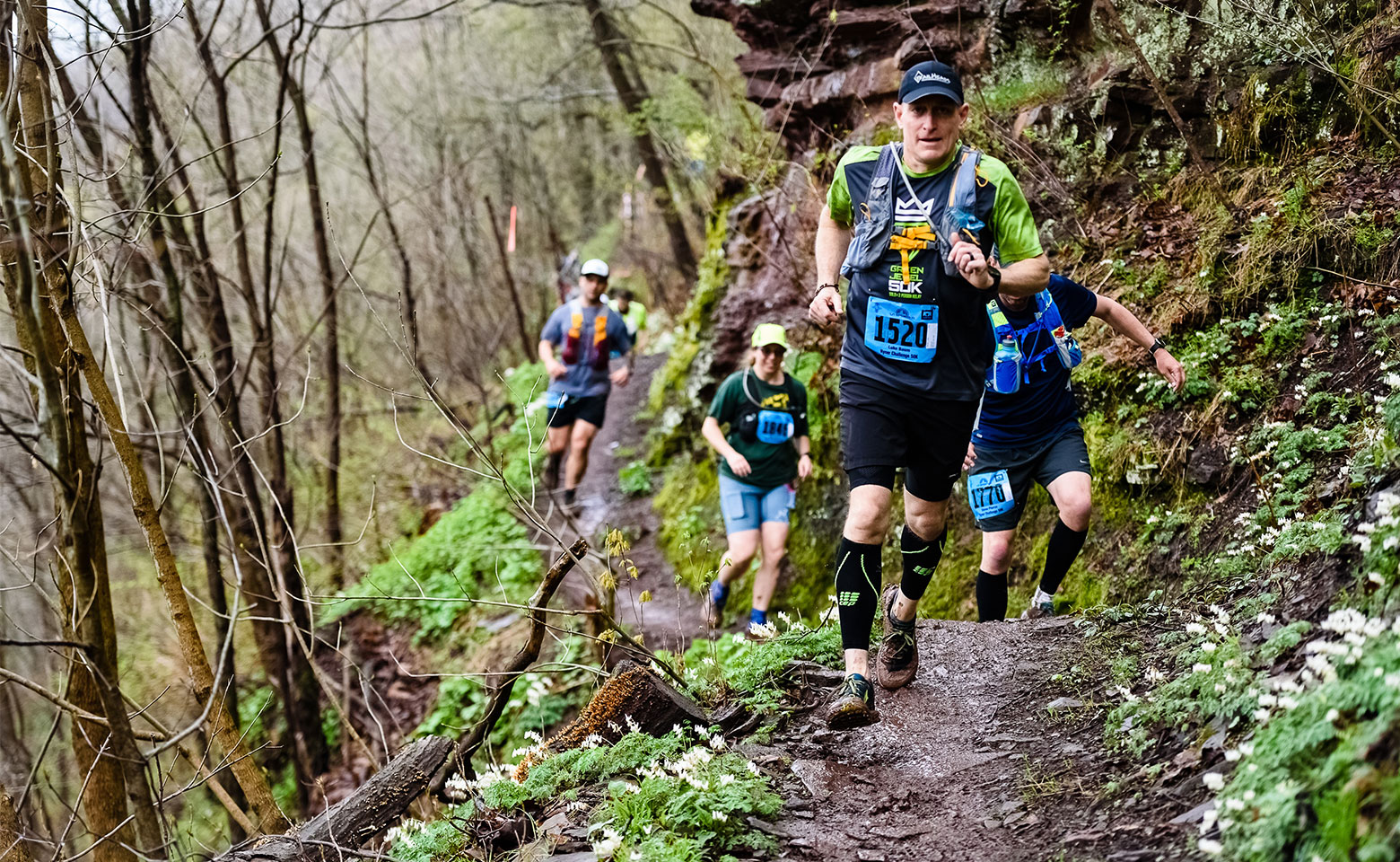

Featured
How To Build Stamina Over 50
Published: October 15, 2023
Discover effective strategies and exercises to build stamina over 50. Our featured tips will help you stay active and energized for a fulfilling life.
Introduction
Welcome to this guide on how to build stamina over 50! As we age, it’s normal for our stamina and endurance to decrease. However, with the right strategies and dedication, it’s possible to regain and even improve our stamina, enabling us to continue enjoying an active and fulfilling life well into our golden years.
Building stamina not only benefits our physical health but also has a positive impact on our mental well-being. It allows us to engage in various activities with greater ease, including walking, running, hiking, cycling, or even participating in sports or adventurous pursuits.
Age should never be a limitation when it comes to maintaining a healthy and active lifestyle. By focusing on building stamina, we can overcome the challenges that come with aging and continue to live life to the fullest.
In this guide, we will explore the importance of building stamina, assess our current stamina levels, set realistic goals, and discover effective strategies to enhance our endurance over 50. We will delve into the realms of cardiovascular exercises, strength training, flexibility workouts, nutrition, hydration, rest, and recovery techniques.
Whether you are a seasoned athlete looking to maintain your stamina or someone who has become sedentary and wants to regain your energy levels, this guide will provide you with valuable insights and practical tips to help you along your journey.
Remember, building stamina is not a sprint but a gradual and sustainable process. Consistency and patience are key, so let’s get started on this exciting path to improving our stamina over 50!
Importance of Building Stamina Over 50
Building stamina becomes increasingly important as we age, particularly once we reach the milestone of 50 years old. As our bodies naturally undergo physiological changes, such as a decrease in muscle mass and a decline in aerobic capacity, it’s crucial to prioritize and actively work on improving our stamina.
Here are a few key reasons why building stamina over 50 is essential:
- Enhanced Energy Levels: Improved stamina allows us to have more energy throughout the day, enabling us to accomplish daily tasks with ease and vitality. Whether it’s keeping up with grandchildren, maintaining an active social life, or pursuing hobbies, having sufficient stamina is crucial for a fulfilling and independent lifestyle.
- Reduced Risk of Chronic Diseases: Regular physical activity, which helps build stamina, has been consistently linked to a reduced risk of chronic diseases such as heart disease, diabetes, and certain types of cancer. By improving our stamina, we strengthen our cardiovascular system, boost our immune function, and lower our risk of developing these serious health conditions.
- Mental Well-being: Engaging in exercises that build stamina releases endorphins, which are natural mood boosters. Regular physical activity has been shown to reduce symptoms of stress, anxiety, and depression, leading to improved mental well-being and overall quality of life.
- Maintained Independence: Building stamina allows us to maintain our independence as we age. By keeping our bodies strong and resilient, we can continue to perform daily activities, such as carrying groceries, climbing stairs, and maintaining balance, without relying heavily on assistance from others.
It’s important to note that building stamina is not just about the physical benefits. It also has a profound impact on our self-confidence, self-esteem, and overall sense of achievement. By pushing our limits and gradually increasing our endurance levels, we challenge ourselves and prove that age is not a barrier to progress and personal growth.
Now that we understand the importance of building stamina over 50, let’s delve deeper into how we can assess our current stamina levels and set realistic goals to embark on this journey toward improved endurance and vitality.
Assessing Your Current Stamina Level
Before embarking on any journey to build stamina over 50, it’s important to assess your current stamina level. This will help you understand where you stand and set realistic goals for improvement. Here are some effective ways to assess your current stamina:
- Cardiovascular Fitness: One way to assess your cardiovascular fitness is to measure your resting heart rate. A lower resting heart rate indicates a healthier heart and better cardiovascular endurance. You can measure your resting heart rate by checking your pulse first thing in the morning, before any physical activity. A resting heart rate between 60-100 beats per minute is considered normal for adults. However, a lower resting heart rate is generally a positive indicator of cardiovascular fitness.
- Endurance Activities: Engage in activities that require endurance, such as brisk walking, jogging, or cycling. Pay attention to how long you can sustain these activities before feeling fatigued or out of breath. Keep a record of the distances covered or the duration of these activities. This will give you a baseline to measure your progress as you work on building stamina.
- Rating of Perceived Exertion (RPE): The Borg Rating of Perceived Exertion scale is a subjective method to assess the intensity of your exercise. It rates your perception of how hard or easy the exercise feels on a scale from 6 to 20, with 6 being very light and 20 being maximal exertion. It can be a useful tool to gauge your effort level during workouts and track your progress over time.
- Functional Movements: Evaluate your ability to perform everyday movements with ease. Can you climb stairs without feeling winded? Can you carry groceries or lift objects without straining? These functional movements are indicators of overall stamina and strength.
By assessing your current stamina level through these methods, you will have a clear starting point for your stamina-building journey. Remember, everyone’s starting point is different, and it’s essential to be honest with yourself and not compare your level to others. The aim here is to focus on gradual improvements and celebrate each small milestone achieved.
Once you have assessed your current stamina level, the next step is to set realistic goals. We’ll explore the process of goal-setting and how it can provide direction and motivation in the quest to improve stamina over 50 in the next section.
Setting Realistic Goals
When it comes to building stamina over 50, setting realistic goals is crucial for success. Realistic goals provide direction, motivation, and a sense of accomplishment as you progress on your journey. Here are some key steps to help you set effective and attainable goals:
- Evaluate Your Current Abilities: Reflect on your current stamina level, taking into account your assessments from the previous section. Consider your strengths, weaknesses, and any limitations you may have. This self-awareness will help you establish goals that are relevant to your capabilities.
- Set Specific, Measurable, Attainable, Relevant, and Time-bound (SMART) Goals: SMART goals are a proven method for setting achievable objectives. Ensure your goals are Specific, clearly defining what you want to achieve. Make them Measurable, using metrics like time, distance, or repetitions to track your progress. Ensure they are Attainable, challenging but realistic considering your current fitness level. Make them Relevant to your overall stamina-building objective. Lastly, set a Time-bound deadline for each goal to provide a sense of urgency and accountability.
- Break Down Your Goals: Large goals can be intimidating, so break them down into smaller, more manageable milestones. For example, if your ultimate goal is to run a 5K, start by aiming to run for 10 minutes non-stop, then increase your time gradually. Breaking down your goals allows you to celebrate small victories along the way and keeps you motivated.
- Be Realistic: It’s crucial to set goals that are realistic for your age, fitness level, and lifestyle. While it’s important to challenge yourself, setting unrealistic goals can lead to frustration and disappointment. Consider factors such as time commitments, physical limitations, and other responsibilities when establishing your goals.
- Adjust and Adapt: As you progress on your journey to build stamina, be open to adjusting and adapting your goals. Your fitness level may improve faster or slower than anticipated, and it’s important to make changes as necessary. Don’t be discouraged if you need to modify your goals—flexibility is key to long-term success.
Remember, the key to setting realistic goals is to find the balance between pushing yourself to improve and ensuring that your goals are achievable given your unique circumstances. By following these steps and setting realistic goals, you’ll be on the right track towards building stamina over 50 and experiencing the numerous benefits that come with it.
Adopting a Balanced Exercise Routine
Building stamina over 50 requires a balanced exercise routine that addresses different aspects of fitness. Incorporating a variety of exercises will not only enhance your stamina but also improve your overall health and well-being. Here are key components to consider when adopting a balanced exercise routine:
- Cardiovascular Exercises: Cardiovascular exercises, also known as aerobic exercises, are essential for building stamina and improving your heart and lung health. Include activities such as brisk walking, running, cycling, swimming, or dancing in your routine. Aim for at least 150 minutes of moderate-intensity aerobic exercise each week, or 75 minutes of vigorous-intensity exercise, or a combination of both.
- Strength Training: Strength training is crucial for increasing muscular strength and endurance, which in turn supports stamina building. Include exercises that target all major muscle groups, such as squats, lunges, push-ups, and rows. Aim for two to three strength training sessions per week, focusing on different muscle groups each session. Start with lighter weights or resistance bands and gradually increase the intensity over time.
- Flexibility Workouts: Flexibility exercises improve your range of motion, reduce the risk of injury, and contribute to overall stamina building. Incorporate activities like yoga, Pilates, or stretching exercises into your routine. Aim for a minimum of two to three flexibility workouts per week, focusing on stretching major muscle groups before and after each exercise session.
- Interval Training: Interval training involves alternating between bursts of high-intensity exercises and periods of rest or lower-intensity activity. It is a highly effective method for improving stamina and cardiovascular fitness. For example, incorporate intervals of sprinting or cycling at maximum effort for 30 seconds, followed by 30 seconds of recovery at a lower intensity. Repeat these intervals for a total of 10-15 minutes as part of your cardiovascular workout.
- Cross-Training: To prevent boredom and reduce the risk of overuse injuries, incorporate cross-training into your routine. This involves engaging in different types of exercises to work different muscle groups and challenge your body in various ways. For example, alternate between cardio exercises, strength training, and flexibility workouts throughout the week.
Remember to always warm up before and cool down after each exercise session. Listen to your body, and if you experience pain or discomfort, adjust the intensity or seek guidance from a healthcare professional or fitness trainer.
By adopting a balanced exercise routine that includes cardiovascular exercises, strength training, flexibility workouts, interval training, and cross-training, you will effectively build stamina, improve your fitness level, and enhance your overall well-being.
Incorporating Cardiovascular Exercises
Cardiovascular exercises are a key component of building stamina over 50. These exercises elevate your heart rate, increase lung capacity, and improve overall cardiovascular health. By incorporating cardiovascular exercises into your routine, you can enhance your stamina, endurance, and energy levels. Here are some effective ways to include cardiovascular exercises:
- Walking: Walking is a low-impact exercise that is accessible to almost everyone. Begin by incorporating brisk walking into your routine for at least 30 minutes a day. Gradually increase the intensity by adding inclines or incorporating interval training, such as alternating between fast-paced walking and a slower pace.
- Running or Jogging: If you’re looking for a higher intensity cardiovascular workout, consider running or jogging. Start with shorter distances or intervals and gradually increase the duration and intensity as your stamina improves. Remember to invest in good running shoes and pay attention to proper form and technique to minimize the risk of injury.
- Cycling: Cycling is a great low-impact cardiovascular exercise that targets the leg muscles and gets your heart rate up. You can cycle outdoors or use a stationary bike at home or in the gym. Challenge yourself by increasing resistance or incorporating interval training. If you prefer a group setting, consider joining a spin class for added motivation.
- Swimming: Swimming is a fantastic full-body workout that is gentle on the joints. It provides both cardiovascular conditioning and resistance training. Consider incorporating different strokes and intervals to vary the intensity of your swim sessions. Whether you choose to swim laps, participate in water aerobics, or take part in water sports, swimming can significantly improve stamina and overall fitness.
- Aerobic Classes: Joining aerobic classes, such as dance fitness, Zumba, or step aerobics, can make cardiovascular exercises more enjoyable and engaging. These classes incorporate choreographed movements and music to keep you motivated and energized while improving your stamina. Participate in classes that suit your fitness level and preferences.
Remember to start gradually and listen to your body. Aim for at least 150 minutes of moderate-intensity aerobic exercise or 75 minutes of vigorous-intensity aerobic exercise each week. Spread your cardiovascular exercise sessions throughout the week to allow for proper recovery and optimal stamina building.
Make cardiovascular exercises a regular part of your routine to experience the benefits of improved stamina, elevated mood, increased energy levels, and better overall cardiovascular health.
Strength Training for Improved Stamina
Strength training is a crucial component of building stamina over 50. By incorporating strength training exercises into your routine, you can improve muscular strength and endurance, which directly contribute to enhanced stamina. Here are some key points to consider when incorporating strength training:
- Choose the Right Exercises: Select a variety of exercises that target all major muscle groups, including your arms, legs, back, chest, and core. Incorporate compound exercises that work multiple muscle groups simultaneously, such as squats, lunges, push-ups, rows, and overhead presses. Include both bodyweight exercises and exercises that utilize resistance bands, free weights, or weight machines.
- Focus on Proper Technique: Pay attention to proper form and technique when performing strength training exercises. This will not only maximize the effectiveness of the exercise but also minimize the risk of injury. If you’re new to strength training, consider working with a qualified fitness professional who can guide you and ensure you’re performing the exercises correctly.
- Gradually Increase Intensity: Start with lighter weights or resistance and gradually increase the intensity as your muscles adapt and become stronger. Aim to challenge yourself without sacrificing proper form. Increase the weight, resistance, or repetitions gradually over time to continue stimulating your muscles and improving stamina.
- Include Circuit Training: Circuit training combines strength training with cardiovascular exercise, resulting in a highly efficient and effective way to improve both muscular endurance and stamina. Designate a set of exercises and perform them one after another with little to no rest in between. This keeps your heart rate elevated while simultaneously targeting different muscle groups.
- Allow for Rest and Recovery: Ensure you allow your muscles sufficient time to rest and recover between strength training sessions. Aim for strength training sessions two to three times per week, alternating muscle groups to give each group time to recover. Adequate rest and recovery are essential for improved stamina and prevent overtraining injuries.
Strength training not only improves muscular strength and endurance but also enhances bone health, increases metabolism, and supports overall functional fitness. It can boost your stamina by enabling your muscles to work more efficiently and for longer periods.
Remember to start with weights or resistance that challenge your muscles but still allow you to maintain proper form. As you progress, you can gradually increase the intensity to continue building strength and stamina over time.
By incorporating strength training exercises into your routine, you’ll not only improve your stamina, but also enhance your overall physical performance and functional abilities.
Flexibility Exercises for Endurance
Flexibility exercises play a vital role in building stamina over 50. They help improve range of motion, prevent injuries, and enhance endurance. By incorporating flexibility exercises into your routine, you can improve your overall stamina, performance, and overall well-being. Here are some key points to consider when including flexibility exercises:
- Static Stretching: Static stretching involves holding a stretch position for a brief period, typically around 20-30 seconds, without any bouncing or jerking movements. Perform static stretches for major muscle groups such as your hamstrings, quadriceps, calves, shoulders, and chest. Aim to stretch both sides of your body evenly.
- Dynamic Stretching: Dynamic stretching involves moving body parts through a full range of motion in a controlled manner. It helps improve blood flow, warm up muscles, and increase flexibility. Incorporate dynamic stretches, such as arm circles, leg swings, and torso twists, into your warm-up routine before engaging in any cardiovascular or strength training exercises.
- Yoga and Pilates: Yoga and Pilates are excellent forms of exercise that improve flexibility, strength, and endurance. These practices involve a combination of stretching, strength-based movements, and controlled breathing. Consider attending classes or following online videos to learn proper techniques and postures.
- Foam Rolling: Foam rolling, also known as self-myofascial release, involves applying pressure to certain areas of the body using a foam roller. This can help release tension and tightness in the muscles, improve flexibility, and enhance overall endurance. Incorporate foam rolling as part of your cool-down routine after workouts or as a standalone practice.
- Prioritize Post-Workout Stretching: After each workout, spend a few minutes performing post-workout stretches targeting the muscles you worked during the session. This helps prevent muscle soreness, aids in recovery, and promotes overall flexibility and endurance.
Remember to perform flexibility exercises on a regular basis, ideally incorporating them into your routine at least two to three times per week. Aim for a minimum of 10-15 minutes per session, focusing on major muscle groups and stretches that target areas of tightness or discomfort.
Incorporating flexibility exercises into your routine not only improves your endurance and stamina but also helps you move more efficiently, reduces the risk of injuries, and enhances overall physical performance. Enjoy the benefits of improved flexibility and endurance by prioritizing these exercises in your fitness routine.
Proper Nutrition for Stamina Building
Proper nutrition plays a crucial role in building stamina over 50. Fueling your body with the right nutrients not only supports your overall health but also provides the energy necessary for improved endurance. Here are some key considerations for maintaining a balanced and nutritious diet for stamina building:
- Adequate Caloric Intake: Ensure you consume enough calories to meet the energy demands of your workouts and daily activities. Caloric needs vary based on factors such as age, gender, weight, activity level, and individual metabolism. Consult with a healthcare professional or registered dietitian to determine your specific caloric needs and create a personalized meal plan.
- Obtain Sufficient Protein: Protein is essential for muscle repair and growth. Include sources of high-quality protein in your diet, such as lean meats, poultry, fish, eggs, dairy products, legumes, and plant-based proteins like tofu and tempeh. Aim for a balanced intake of protein throughout the day to support stamina building and overall muscle health.
- Complex Carbohydrates: Carbohydrates are the body’s primary source of fuel. Opt for complex carbohydrates like whole grains, fruits, vegetables, and legumes, which provide a sustained release of energy. These carbohydrates contain essential vitamins, minerals, and fiber to support overall health and maintain stable blood sugar levels.
- Healthy Fats: Include sources of healthy fats in your diet, such as avocados, nuts, seeds, olive oil, and fatty fish like salmon or trout. Healthy fats provide essential fatty acids, support brain health, and aid in the absorption of fat-soluble vitamins. They also help to promote satiety and provide a source of sustained energy.
- Stay Hydrated: Proper hydration is vital for optimal stamina and endurance. Drink enough water throughout the day to stay hydrated, especially before, during, and after exercise. It’s important to listen to your body and replenish fluids lost through sweat. Consider incorporating electrolyte-rich drinks for intense or prolonged workouts to replace key minerals lost through perspiration.
A balanced and varied diet that includes a mix of lean proteins, complex carbohydrates, healthy fats, and plenty of fruits and vegetables provides the necessary nutrients for stamina building. Pay attention to portion sizes and listen to your body’s hunger and fullness cues.
While proper nutrition is essential, it’s important to remember that individual dietary needs may vary. Consider consulting with a registered dietitian or nutritionist to create a personalized nutrition plan that aligns with your specific goals, preferences, and any specific dietary restrictions you may have.
By fueling your body with the right nutrients, you’ll optimize your stamina building efforts and support overall health and well-being.
Hydration Tips for Endurance
Proper hydration is essential for endurance and stamina building, especially for individuals over 50. Dehydration can negatively impact performance, energy levels, and overall health. Here are some important hydration tips to keep in mind:
- Drink Plenty of Water: Ensure you consume an adequate amount of water throughout the day. Hydration needs can vary based on several factors such as activity level, climate, and individual characteristics. Aim to drink at least 8 cups (64 ounces) of water per day as a general guideline, and increase your intake during periods of intense physical activity or when in hot, humid environments.
- Monitor Urine Color: Pay attention to the color of your urine as an indicator of hydration levels. Light or pale urine generally indicates proper hydration, while dark-colored urine can be a sign of dehydration. Aim for a light, straw-colored urine as an indicator of adequate hydration.
- Pre- and Post-Workout Hydration: Drink water before and after your workouts to maintain hydration levels. It’s recommended to drink 16 to 20 ounces of water two hours before exercise and another 8 to 10 ounces 15 minutes before starting. After your workout, replenish fluids by drinking 16 to 24 ounces of water per pound lost during exercise.
- Monitor Sweat Loss: Weigh yourself before and after your workouts to estimate fluid loss from perspiration. For each pound lost during exercise, aim to drink 16 to 24 ounces of water. This helps replenish fluid levels and maintain proper hydration.
- Consider Electrolyte Replenishment: Endurance activities lasting longer than an hour may require electrolyte replenishment to replace minerals lost through sweat. Consider consuming sports drinks or electrolyte tablets during prolonged workouts or in hot and humid conditions. These can help maintain electrolyte balance and prevent symptoms of dehydration, such as muscle cramps.
- Listen to Your Body: Pay attention to your body’s thirst cues. Thirst is a natural mechanism indicating the need for fluid replenishment. Don’t wait until you feel excessively thirsty to drink water, as this may indicate you are already dehydrated. Sip water regularly throughout the day to stay adequately hydrated.
Remember that individual hydration needs can vary, so it’s important to listen to your body and adjust your fluid intake accordingly. Make hydration a priority throughout the day, not just during exercise sessions. Carry a water bottle with you as a reminder to drink water regularly.
By following these hydration tips, you’ll optimize your endurance and stamina-building efforts, promote overall health, and ensure your body functions optimally during physical activities.
Rest and Recovery Techniques
Rest and recovery are essential components of building stamina over 50. Proper rest allows your body to repair, rebuild, and adapt to the demands of physical activity, ultimately enhancing your endurance and overall fitness level. Here are some key rest and recovery techniques to incorporate into your routine:
- Get Adequate Sleep: Quality sleep is crucial for optimal recovery and stamina building. Aim for 7-9 hours of uninterrupted sleep each night. Create a relaxing sleep environment, establish a regular bedtime routine, and limit screen time before bed to promote better sleep.
- Incorporate Active Rest Days: Rest days should be an integral part of your fitness routine. These days allow your body to recover and rejuvenate. Consider incorporating active rest days, where you engage in light activities like gentle stretching, walking, or yoga. These activities help promote blood circulation and aid in muscle recovery.
- Listen to Your Body: Pay attention to your body’s signals and respect its limits. If you feel tired, excessively sore, or experience pain, it’s important to rest and allow your body time to recover. Overtraining can be counterproductive and increase the risk of injury or burnout.
- Practice Deep Breathing and Relaxation Techniques: Engaging in deep breathing exercises, meditation, or other relaxation techniques can help reduce stress levels and promote relaxation. Stress can negatively impact your stamina-building efforts, so commit to incorporating stress-reducing practices into your routine.
- Use Cooling Techniques: After intense workouts or physical activities, consider using cooling techniques such as cold showers, ice baths, or the application of cold packs to reduce inflammation and promote faster recovery. These techniques can help decrease muscle soreness and aid in the recovery process.
- Massage or Self-Myofascial Release: Schedule regular massages or use self-myofascial release techniques, such as foam rolling or using a massage ball, to alleviate muscle tension, improve blood circulation, and enhance recovery. These techniques can help relieve soreness and improve muscle function.
- Hydrate and Eat Nutritious Foods: Proper nutrition supports recovery and replenishes energy stores. Ensure you consume a well-balanced diet rich in lean proteins, complex carbohydrates, and healthy fats. Additionally, stay hydrated by drinking adequate amounts of water throughout the day to aid in the recovery process.
- Alternate High-Intensity and Low-Intensity Workouts: To prevent overexertion and reduce the risk of injuries, alternate high-intensity workouts with low-intensity ones. This approach allows specific muscles to recover while still maintaining an active lifestyle. Mix and match your workouts to include a variety of activities and intensities throughout the week.
Remember, rest and recovery are just as important as the workouts themselves when it comes to building stamina. By incorporating these techniques into your routine, you’ll optimize your body’s ability to adapt, recover, and improve endurance over time.
Overcoming Common Challenges
Building stamina over 50 may come with its own set of challenges. However, with the right mindset and strategies, you can overcome these challenges and continue progressing on your journey to improved endurance. Here are some common challenges and tips to overcome them:
- Motivation: Staying motivated can be a challenge, especially when faced with daily responsibilities and the natural decrease in energy levels that comes with age. Find your intrinsic motivation by reminding yourself of the benefits of building stamina, such as improved overall health, mental well-being, and increased independence in daily activities. Setting realistic goals and tracking your progress can also help keep you motivated along the way.
- Time Constraints: Finding time for exercise may seem challenging, especially with busy schedules. Prioritize your physical activity by establishing a routine and scheduling workouts like you would any other important appointment. Look for opportunities to incorporate physical activity throughout the day, such as taking short walks during breaks or engaging in active hobbies.
- Physical Limitations: Accept that your body may have certain limitations and be mindful of them. Consult with a healthcare professional or a qualified fitness trainer to develop a customized exercise plan that considers any existing conditions or injuries. Focus on finding activities that you enjoy and that can be modified to accommodate your specific needs.
- Plateaus: It’s common to experience plateaus in your stamina-building journey, where progress may seem to stall. Shake things up by introducing new exercises, increasing the intensity of your workouts or trying different forms of exercise. Cross-training, participating in group fitness classes, or working with a personal trainer can provide fresh challenges and help break through plateaus.
- Discipline and Consistency: Maintaining discipline and consistency may be challenging, especially when life gets busy or when faced with setbacks. Approach your stamina-building journey with a long-term perspective and understand that consistent effort over time is key. Set achievable goals and establish a supportive environment that encourages sticking to your routine. Celebrate small victories and remind yourself of the progress you’ve made.
- Mental Barriers: Overcoming mental barriers, such as self-doubt or fear of failure, is essential for building stamina. Practice positive self-talk, focus on your strengths and achievements, and surround yourself with a supportive community. Engage in activities that cultivate a positive mindset, such as mindfulness, meditation, or visualization techniques.
- Listening to Your Body: Learn to listen to your body and honor its needs. Pay attention to signs of overexertion, fatigue, or injury. Practice self-care by incorporating rest days, proper nutrition, and recovery techniques into your routine. Remember that progress is a journey and that rest and recovery are vital for long-term success.
- Adjusting to Aging: As we age, our bodies naturally undergo changes that can affect stamina and endurance. Embrace and accept these changes, understanding that building stamina is a process that adapts to our evolving needs. Focus on what your body is capable of now and work toward realistic goals that align with your current abilities.
Remember, building stamina is a personal journey, and everyone’s path may differ. Embrace the challenges as learning opportunities, and approach them with patience, persistence, and a positive mindset. By overcoming these challenges, you’ll continue progressing and enjoying the benefits of improved stamina well into your 50s and beyond.
Conclusion
Congratulations on completing this comprehensive guide on how to build stamina over 50! By now, you should have a solid understanding of the importance of stamina building, how to assess your current stamina level, set realistic goals, and adopt a balanced exercise routine. You’ve also learned about the significance of incorporating cardiovascular exercises, strength training, flexibility workouts, proper nutrition, hydration, rest, and recovery techniques into your routine. Additionally, we explored strategies for overcoming common challenges that may arise during your stamina-building journey.
Remember, building stamina is a gradual and sustainable process. It requires consistency, patience, and a commitment to your overall well-being. By prioritizing your health, setting realistic goals, listening to your body, and making adjustments as needed, you will make progress towards improving your stamina and discovering the joy of an active and fulfilling lifestyle.
Keep in mind that everyone’s stamina-building journey is unique, and your path may differ from others. Embrace the challenges, celebrate your achievements, and continue to push yourself within your personal limits. Stay motivated, practice self-care, and surround yourself with a supportive network that encourages your progress.
It’s never too late to invest in your stamina and endurance. Whether you’re an avid athlete or someone looking to regain their energy levels, the benefits of building stamina over 50 are numerous – enhanced energy, reduced risk of chronic diseases, mental well-being, and maintained independence, to name a few.
Now, armed with the knowledge and strategies provided in this guide, it’s time to embark on your stamina-building journey. Embrace the challenge, stay committed, and enjoy the transformation that awaits you. Remember, age should never be a limitation – the possibilities are endless when it comes to building stamina and living life to the fullest.









